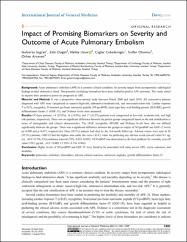| dc.contributor.author | Sagcan, Gulseren | |
| dc.contributor.author | Doğan, Zeki | |
| dc.contributor.author | Uzun, Hafize | |
| dc.contributor.author | Cuhadaroglu, Cağlar | |
| dc.contributor.author | Okumuş, Gülfer | |
| dc.contributor.author | Arseven, Orhan | |
| dc.date.accessioned | 2024-01-03T09:07:11Z | |
| dc.date.available | 2024-01-03T09:07:11Z | |
| dc.date.issued | 2023 | en_US |
| dc.identifier.citation | Sagcan, G., Dogan, Z., Uzun, H., Cuhadaroglu, C., Okumus, G., & Arseven, O. (2023). Impact of Promising Biomarkers on Severity and Outcome of Acute Pulmonary Embolism. International journal of general medicine, 16, 3301–3309. https://doi.org/10.2147/IJGM.S416541 | en_US |
| dc.identifier.uri | https://hdl.handle.net/20.500.12900/290 | |
| dc.description.abstract | Background: Acute pulmonary embolism (APE) is a common clinical condition. Its severity ranges from asymptomatic radiological findings to fatal obstructive shock. The potential circulating biomarkers have been studied to predict APE outcomes. This study aimed to explore their predictive power on prognosis in APE.Material and Method: It was a prospective observational study between March 2008 and April 2010. All consecutive patients diagnosed with APE were categorized as massive/high-risk, submassive/moderate-risk, and non-massive/low-risk. Cardiac troponin T (cTnT), myoglobin, N-terminal pro-brain natriuretic peptide (NT-proBNP), heart-type fatty acid-binding protein (H-FABP), growth differentiation factor-15 (GDF-15), and D-dimer levels were measured.Results: Of these patients, 14 (29.8%), 16 (34.0%), and 17 (36.2%) patients were categorized as low-risk, moderate-risk, and high risk-patients, respectively. There was no significant difference between the patient groups categorized based on the risk stratification in terms of demographic and clinical characteristics. The cTnT, myoglobin, HFABP, and D-dimer levels have also not differed significantly between the groups. There was a significant difference between the groups in respect of NT-proBNP and GDF-15 levels (p=0.009 and p=0.037, respectively). Nine (19.1%) patients had died by the 3rd-month follow-up. Adverse events were seen in 26 (55.3%) patients. GDF-15 had the highest area under the curve (AUC) value for predicting any adverse event (cut-off value=9.3 ng/ mL, AUC=0.796, CI (confidence interval) 95%: 0.653-0.899). NT-ProBNP was determined as the best predictor for mortality (cut-off value=229.2 pg/mL, AUC=0.889, CI 95%: 0.756-0.964).Conclusion: Higher levels of NT-proBNP and GDF-15 were found to be associated with more severe APE, worse outcomes, and mortality. | en_US |
| dc.language.iso | eng | en_US |
| dc.publisher | Dove Medical Press Ltd | en_US |
| dc.relation.isversionof | 10.2147/IJGM.S416541 | en_US |
| dc.rights | info:eu-repo/semantics/openAccess | en_US |
| dc.subject | Olumsuz klinik sonuç | en_US |
| dc.subject | Biyobelirteçler | en_US |
| dc.subject | Biomarkers | en_US |
| dc.subject | Büyüme farklılaşma faktörü-15 | en_US |
| dc.subject | Growth differentiation factor-15 | en_US |
| dc.subject | Natriüretik peptitler | en_US |
| dc.subject | Natriuretic peptides | en_US |
| dc.subject | Pulmoner emboli | en_US |
| dc.subject | Pulmonary embolism | en_US |
| dc.title | Impact of Promising Biomarkers on Severity and Outcome of Acute Pulmonary Embolism | en_US |
| dc.type | article | en_US |
| dc.department | İstanbul Atlas Üniversitesi, Tıp Fakültesi, Dahili Tıp Bilimleri Bölümü | en_US |
| dc.authorid | Zeki Doğan / 0000-0002-5620-7268 | en_US |
| dc.authorid | Hafize Uzun/ 0000-0002-1347-8498 | en_US |
| dc.contributor.institutionauthor | Doğan, Zeki | |
| dc.contributor.institutionauthor | Uzun, Hafize | |
| dc.identifier.volume | 16 | en_US |
| dc.identifier.startpage | 3301 | en_US |
| dc.identifier.endpage | 3309 | en_US |
| dc.relation.journal | International Journal of General Medicine | en_US |
| dc.relation.publicationcategory | Makale - Uluslararası Hakemli Dergi - Kurum Öğretim Elemanı | en_US |

















